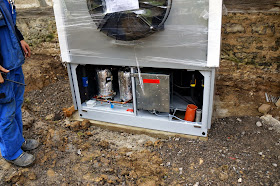Last Friday, our yard was filled with a million euro of mobile crane. As it had been used for another job nearby, Sace got him to pop over and lift the heat pump over the house and barn to place it in its new home.
Yesterday evening, we completed the pipework and back-filling behind the house, so it's no longer so Somme-like.Nevertheless, there'll be a lot of work to do to get that garden in shape! The heat pump isn't the most attractive, but maybe we can hide it a bit.
Next week, some of the internal work begins, at least with getting power sorted for the cellar and heat pump. In the meantime, I'll be continuing with repointing and plastering to get the technics room (AKA Cellar 4) complete.
Sunday, 20 October 2013
Sunday, 13 October 2013
Life in the trenches
The past three weeks have been mostly occupied with two tasks. One, getting the basics ready for the air-source heat pump installation, and related to that, getting some of the final dirty work in cellar 4 completed, so the heating equipment can be given a home.
For the cellar work, it's been an almost nightly task to do a few hours repointing or plastering to get the back area completed before the hot water tank and buffer reservoir (puffer speicher, so not sure what the English technical term is!) are put into place. It's not hard work, but extremely slow. I'm using a mix of trass cement and sand, as trass doesn't have the lime elements of normal cement that can lead to leaching of salts in a damp cellar wall, plus it's a bit more breathable than plain Portland cement. In those areas where the old plaster has been too difficult to completely remove I've simply plastered over with lime-cement plaster.
After three weeks of this, I have about 65% of cellar 4 done. Like I said, slow... But I think it does look a lot better than before, and once completely dried out will be nice and bright. Actually, when I look back on how the cellar looked when we first bought the house, it's quite the transformation!
Last weekend we experienced life in the trenches. Our friend, master electrician Sace, and his son, popped over on the Friday with a mini digger and we began preparing the plinth for the heat pump to stand on, as well as the trenches for laying the necessary pipes into the cellar. Working well into the dark, we got as far as building the shuttering for the plinth, with the intention of pouring concrete the next day. Unfortunately, it rained the whole night, and pretty much all Saturday, but that didn't stop us. By Monday night, we'd gotten as far as getting the pipes in, but ran out of sand, as we'd then found one of the pipes leading to the rainwater cistern had been laid with a slope in the wrong direction. That added a couple of hours work, as we excavated it and reset it so water would actually flow towards the cistern from the barn roof...
So, the next job will be getting the heat pump from the front of the house to its permanent home behind the barn, and filling in the remaining trenches. I'm away for most of the week, so I'm hoping it will be left till my return.
For the cellar work, it's been an almost nightly task to do a few hours repointing or plastering to get the back area completed before the hot water tank and buffer reservoir (puffer speicher, so not sure what the English technical term is!) are put into place. It's not hard work, but extremely slow. I'm using a mix of trass cement and sand, as trass doesn't have the lime elements of normal cement that can lead to leaching of salts in a damp cellar wall, plus it's a bit more breathable than plain Portland cement. In those areas where the old plaster has been too difficult to completely remove I've simply plastered over with lime-cement plaster.
 |
| After blasting, before repointing. |
 |
| After repointing. |
 |
| The end where the equipment will live. |
 |
| "Rustic" plastering. Will be nicer once painted :) |
Last weekend we experienced life in the trenches. Our friend, master electrician Sace, and his son, popped over on the Friday with a mini digger and we began preparing the plinth for the heat pump to stand on, as well as the trenches for laying the necessary pipes into the cellar. Working well into the dark, we got as far as building the shuttering for the plinth, with the intention of pouring concrete the next day. Unfortunately, it rained the whole night, and pretty much all Saturday, but that didn't stop us. By Monday night, we'd gotten as far as getting the pipes in, but ran out of sand, as we'd then found one of the pipes leading to the rainwater cistern had been laid with a slope in the wrong direction. That added a couple of hours work, as we excavated it and reset it so water would actually flow towards the cistern from the barn roof...
 |
| Now that's a drill! Needed one more hole for the pipes. |
 |
| Saturday... wet. Photo's don't do the mud justice. |
 |
| Backfilling in the dark |
 |
| Rough-fitting through cellar wall. Still needs to be sealed. |
 |
| Slippery when wet. |
 |
| The heatpump and water cylinders |



